
New Building FAQ New Building Images
May 2024
This month's entry is an overview of Habonim's future home. In future months, we will walk through the details on specific rooms and areas.
Our new home at 25 West 65th Street will consist of over 31,000 square feet (sf): approximately 22,300 sf on the ground floor and approximately 9,300 sf downstairs on the lower level of the new building. In addition, we will have ~4,600 sf of outdoor space on the ground floor, consisting of the entire courtyard of the new building. Our new 31,000+ sf of indoor space compares to ~15,000 sf in our old building on 66th Street, and ~12,500 sf in our current space on West End Avenue. Our new sanctuary will be ~3,200 sf, compared to ~1,300 sf in our current sanctuary.
In the graphic below, there are 3 drawings:
- On the drawing on the left, you can see geographically where Habonim's old building was, in the context of the new building under construction there.
- In the center, you can see a) our new entrance on 65th Street, b) in dark gray, the outline of our space on the ground floor of the new building (the remaining light gray towards 66th St is the driveway and lobby of the new apartment building), c) on the right, our L-shaped outside space, d) the dotted line representing the outline of our old building.
- On the drawing on the right, you see in yellow the outline of our current ground floor space on West End Avenue, to show the size comparison with our ground floor space in the new building.
The design of our new home began with a review of our space needs and wants with the congregation and Habonim staff. This resulted in a program, covering how we would like to potentially use our new space. This included:
Community/religious spaces
- Lobby/entry area
- Sanctuary that can seat ~300 with high ceilings and no columns
- Ante-room outside the sanctuary for books, kippot, tallit
- Gathering/pre-function space
- Library for multiple purposes - meetings, school use, homework area
- Social hall that can seat ~200 at event tables or ~300 for a lecture, with high ceilings and no columns
- Catering kitchen adjacent to social hall to allow for catered weddings, b'nei mitzvah and other events
- Small dairy kitchen for staff and school use
- Coat rooms on each floor
- Bridal room/private family room with private bathroom, vanity, mirrors
- Chapel/beit midrash/meeting room that can seat ~100 for smaller services and other uses
Education spaces
-
7 classrooms to hold 15 Nursery School students each; each with a bathroom and each with a door to the outdoor play space
-
Storage space for schools
-
Offices for Nursery School and Religious School
-
Nursery School library that can be used as a breakout space
-
Conference room for schools' use
-
Lounge where caregivers can sit and wait, ideally separate from the main entry
Administration spaces
- Rabbi's office, with space for visitors
- Small meeting space adjacent to office
- Cantor's office with space for visitors
- Executive Director office, with space for visitors
- General office
- Security office, with window to entry vestibule
- Maintenance office
Miscellaneous
- Large storage rooms on both floors
- Outdoor area, focused on play space for Nursery School
- Restrooms on both floors
- Wide hallways and stairway to allow circulation throughout the space
We believe that our design has been able to meet these program requirements and desires. There were certainly trade-offs that had to be made in certain areas, but our design will allow Habonim to deliver the services we hope to bring to the congregation and to allow our community to grow well into the future.
We will go in-depth on the plans in future months, but here is a high-level walk-through of the floor plans:
Ground floor
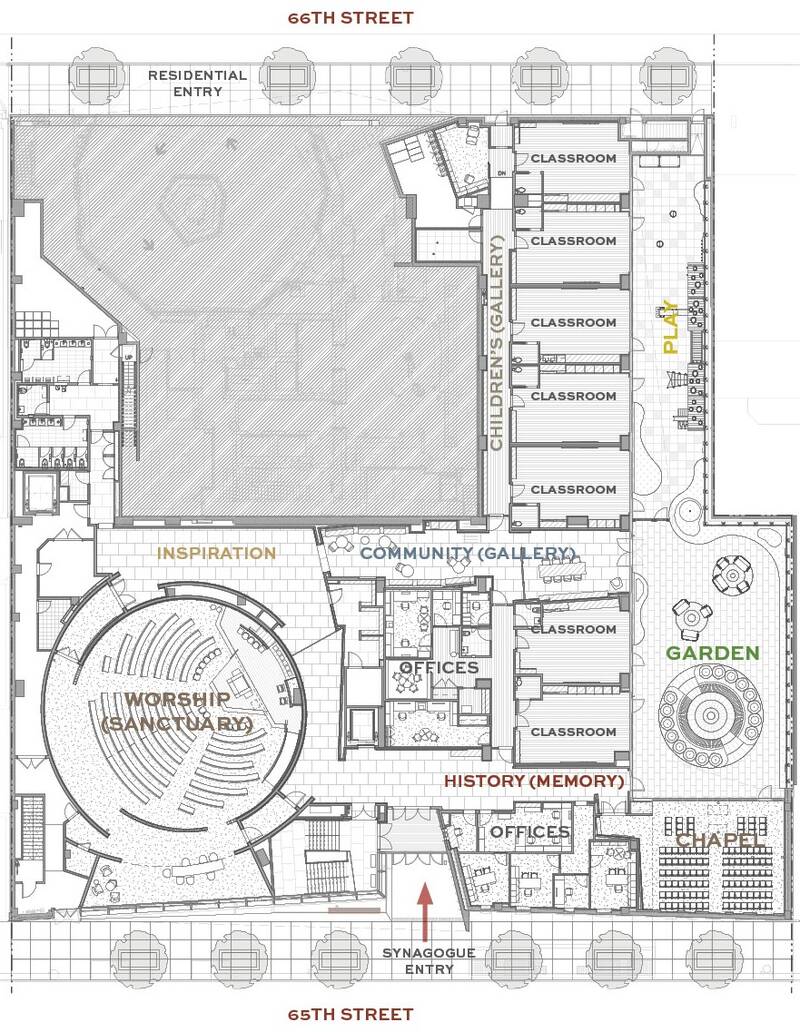
As noted, the front door is on 65th Street. The entire 65th Street side of the new building, approximately 195 feet wide, is Habonim's exterior. Upon entering Habonim, there will be two sets of doors. In between the doors, in the entry vestibule, will be a window into the security office.
After entering the lobby, if you turn left, you will see the stairway down to our lower level as well as our elevator. Making a second turn right and heading north to the back of our space (labeled "Inspiration" on this drawing), you will pass the coat room. Turning left at the back wall you will reach the main entry to the sanctuary, which was purposefully designed to be far from the front door, so that people could shed their coats (and any other "baggage") before entering the sanctuary. Restrooms are on the very top left of the drawing in the back of the space.
Starting again at the front door, but this time turning right after entering, you will pass on your right the security office, the general offices, and a short corridor to the rabbi and cantor offices before reaching the chapel in the southeast corner as well as a door to the courtyard.
If instead of walking all the way to the chapel, you turn left at the offices and head north in the space, you will encounter our 7 classrooms along your right (with the library between classrooms 5 and 6), all the way north to 66th Street. On your left as you walk north, you will pass the school offices and then our lounge area. Further north at the end of the classroom hallway are a small kitchen and small library for the Nursery School. (the grayed out areas on the ground floor plan are not part of Habonim - they are the residential apartment driveway and lobby)
Lastly, there is a service entrance (and emergency exit) on the westernmost part of the 65th Street exterior, leading to a service corridor, stairway, and elevator along the westernmost side of both floors. This door will allow caterers to enter and head directly to the service elevator and kitchen on the lower level. There are also emergency exits to 66th Street at the northernmost end of the classroom hallway and courtyard.
[In response to a congregant question, a few recent photos of our space have been added HERE. The photos were taken looking south from the vantage point of approximately where our 4th classroom will be.]
Lower level

Upon exiting either the stairwell (on the lower right corner of the drawing) or elevator downstairs, you will be in our downstairs lobby. The main space downstairs is our social hall. To the north of the social hall is our catering kitchen. On the east side of the lower level are restrooms, a coat room, and a bridal suite/private family room.
We hope this gives everyone an initial feel for our future home. More details to come in future posts!
*********************************************************************************************************************************************************
How did we design Habonim's new home?
Habonim's history
The design of our new home is intended to reflect our unique history, our values and mission, and our hope for the future. The building of a new home is a celebratory and optimistic act -- as was the building of our original home on 66th Street, beautifully described in a 1952 letter to then Rabbi, Hugo Hahn: “The modern Jew needs more than ever a place of quiet retreat from the rising fever and tumult of the world, a respite from the clamorous demands of his own material interests, a timeless sanctuary where he can lose himself in order to find himself, a powerhouse where his spirit is recharged and energized...” -- Rabbi Manfred Swarsensky

During the design phases, we drew inspiration from the courage of our founders, who understood the significance of building in a new country one year after Kristallnacht. Thanks to research from Dail Stolow and others on the unique history of Congregation Habonim, we considered the destroyed synagogue in Essen, Germany as a means to understand the rich culture and spiritual home that our founders were forced to leave - all with the goal of linking past and present in our design approach.
Design planning
Design planning started in 2013 as the sale of our home on 66th Street was becoming a reality. The Real Estate committee at that time, headed by Lew Krulwich, worked with our architectural firm, BKSK, to define the essential needs of a new site and to set minimum requirements for our space within a new building that was to be built in the future. These requirements included roughly 30,000 square feet of usable space, significant street frontage, clear spans and high ceilings for the Sanctuary and Social Hall, and access to an outdoor play space for the nursery school.
Habonim's ultimate footprint has met all these requirements and more with abundant natural light, 4600 square feet of outdoor space, and high ceilings throughout. The new building will give Habonim a strong street presence on 65th Street signaling our identity as a contemporary synagogue.
Congregation input
Input was received throughout the design process from the congregation. We started our process in 2015 with a series of programming meetings to review the spatial requirements for the new space. The Real Estate committee and our architects met with small groups of congregants representing the preschool, the religious school, “Shabbat regulars”, teens, the “Queens group”, staff and administration as well as holding open congregational meetings to get input and hear concerns. The goal was to establish a shared vision for the design and to ensure that a full range of voices were heard. While each meeting brought a new perspective and specific insights, there was a distinctive and shared vision for the new building. We then held open meetings with congregants to share our findings.
During these meetings, we heard a variety of voices, concerns, and suggestions. While some feelings had consensus, such as "Congregation Habonim is intimate, homey, and everyone knows everyone, like an extended family," in other areas we heard contradictory opinions, making it clear every element of the design would not satisfy every opinion, and decisions would have to be made. For example, we heard "The space should be simple, simple, simple, elegant and homey. It is not a place for chandeliers and glitter," as well as "The design should include “meaningful bells and whistles”, and should “reach for the stars” Some expressed the contradictions inherent in designing a new home: "It is important to maintain the connections to the past and its traditions, while simultaneously looking forward." or "The entry should feel welcoming, but security is paramount."
We heard specific, practical, suggestions such as "The offices (clergy and administrative) should be near to the entrance in order to be welcoming - they should not be buried deeply within the space." And certain aspects were designed based on congregant comments. For example, the sequence of walking through the lobby, past the coat room, around to the sanctuary entry, and through an ante-room into the sanctuary was designed based on multiple congregants' description of its importance: "The entry procession / dressing / disrobing are all part of the religious experience and leaving the secular world behind." "The entry sequence is part of the “spiritual transition” and part of the learning experience." "An ante space is important, acoustically separate from the Sanctuary." "Children should feel welcome in the Sanctuary and this ante area should act as a welcoming transition space."
Similarly, the sanctuary was designed based on input from the congregation: "The Sanctuary should feel warm and be made of simple honest materials. It should be monumental and transcendent, but modern." "The current horseshoe arrangement provides intimacy — it gives the feeling of a gathering space where one is aware of the other congregants." "The bimah should be raised only minimally if at all, depending on sight lines, and allow for seating for 4-6 people, and space for 2 torah stands. Any rise should be accessible by a ramp." "If possible, point sanctuary toward Jerusalem." "The presence of children is important - parents with children want to be part of the service." "The space should feel welcoming to children- they shouldn’t be isolated. We want them to grow into the Sanctuary.” "“We like the sound of children”. The space wants to communicate that “we want you here”."
Design process
In order to develop a shared visual language, the Real Estate committee and BKSK visited other synagogues in NYC, Westchester and New Jersey. These visits allowed us to hear from other congregations about their lessons learned in developing a new home, as well as to see alternate designs as a point of departure for our own discussions.
During 2016-18, our architects met, often biweekly, with the Real Estate Committee, headed by Michael Harwayne since 2014 and including members during this design period Deborah Moelis, Paul Millman, Richie Kargauer, Norbert Fruehauf, Elaine Witkoff, Neil Goldstein, Rich Verner, Rabbi Katzan and Rabbi Gelber, and Cantor Halev. We established design criteria, reviewed alternate solutions and made decisions. This included meetings with consultants (Mechanical/Electrical/Plumbing Engineers, Lighting, AV, IT, Acoustics, Security, Signage, Landscape, Kitchen) as appropriate to review their disciplines. The process was iterative; the design team would present options that responded to the stated program goals and these would then be reworked to acknowledge received feedback. The group expanded to include others as appropriate, including Habonim staff and congregants with relevant expertise. At project milestones (at the end of Programming, Schematic Design, Design Development and Construction Documents) the design was presented to the Executive Committee and the full Board. The design was also presented at key junctures at meetings open to the full Congregation.
Due to delays in the construction of the overall building on 65th Street (discussed in last month's blog entry below), our completed architectural plans sat on a shelf for several years. In 2023 as we started getting closer to beginning our build-out work, the Real Estate Committee, now consisting of Michael Harwayne, Deborah Moelis, Norbert Fruehauf, Neil Goldstein, Rich Verner, Abigail Schlaff, Marc Mehl, Debra Karlstein, Wendy Halperin, and Susan Grant, reviewed our plans with our architects and a contractor, Benchmark Builders, and made tweaks to certain materials, furnishings, and equipment so our designs would still be affordable, given recent inflation, while maintaining our original floor plan and uses of our space and ensuring that our space will be welcoming and beautiful. This spring, our architects are readying and updating our drawings, including reviewing for code/technology changes, so that we can take them out to get contractor bids later this year.
In coming months in this space, we will review each area of the plan to familiarize the congregation with the design details.
*********************************************************************************************************************************************************
Hello Habonim members!
This is the first of many posts about our new home, which will be at 25 West 65th Street, between Central Park West and Columbus Avenue. This is an exciting time for Habonim and the Real Estate Committee wants all members to be informed and engaged with the process! For our first entry, we'd like to recap a bit of the history bringing us to this point so everyone in the congregation has the same baseline information:
Why did we embark on this process?
-
Improving and expanding Habonim's physical structure has been a dream of the congregation for decades, as we were out of space in our old building on 66th Street for the services and programs we wanted to provide the Congregation.

-
Take a look at this page from the 1984 (!) Habonim Gala Journal, showing a rendering of a high rise building on our old site. A bit ahead of its time.
-
There were multiple attempts over the decades, including architectural plans developed many years ago to move into the 66th Street armory adjacent to our old building (see below). For a variety of reasons -- financial, logistical, and otherwise -- these efforts never came to fruition.
-
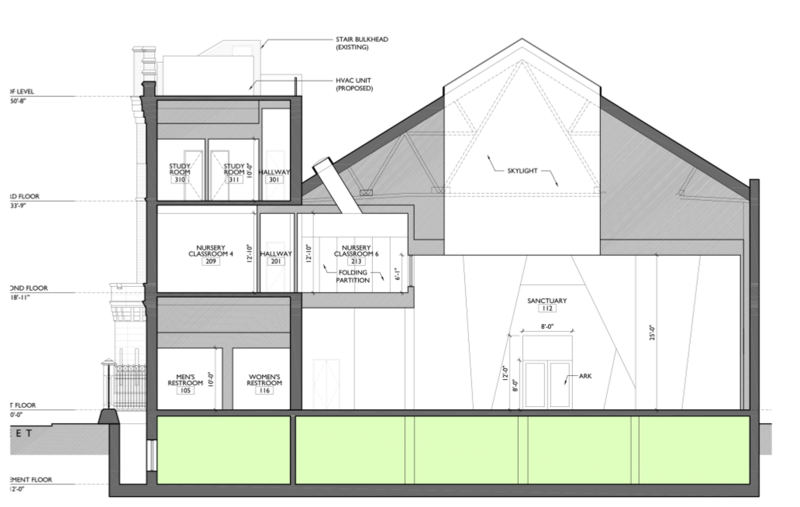
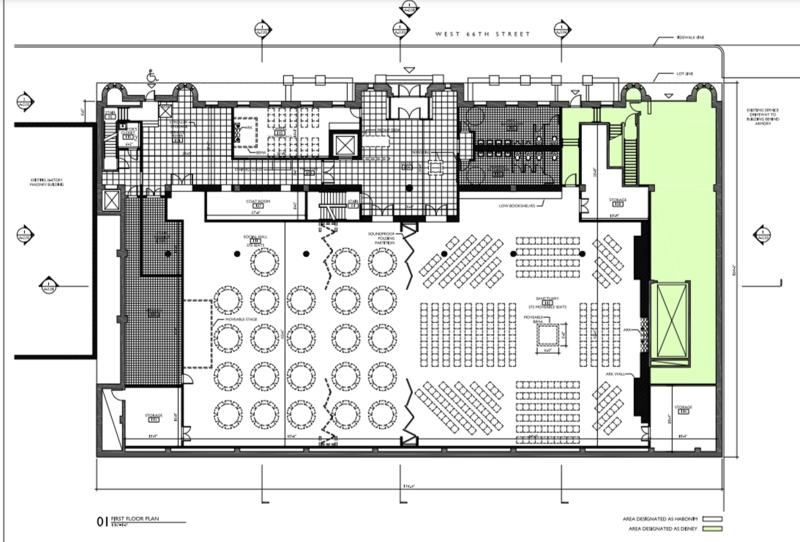
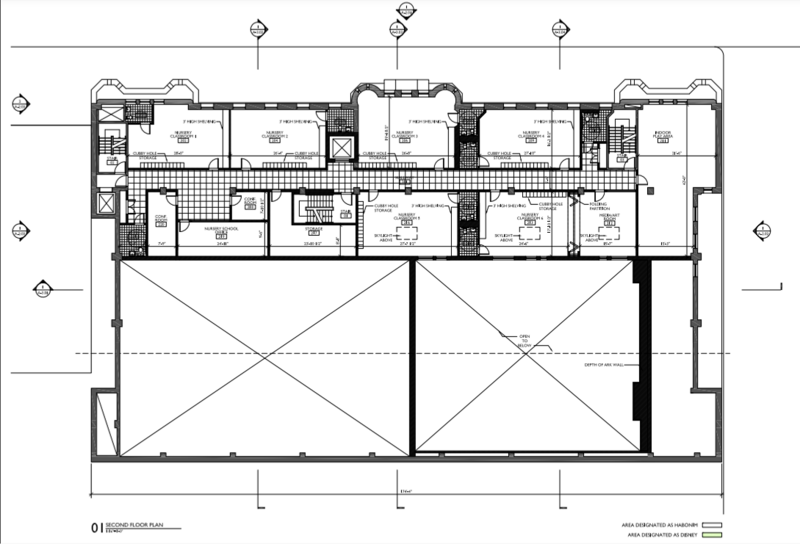
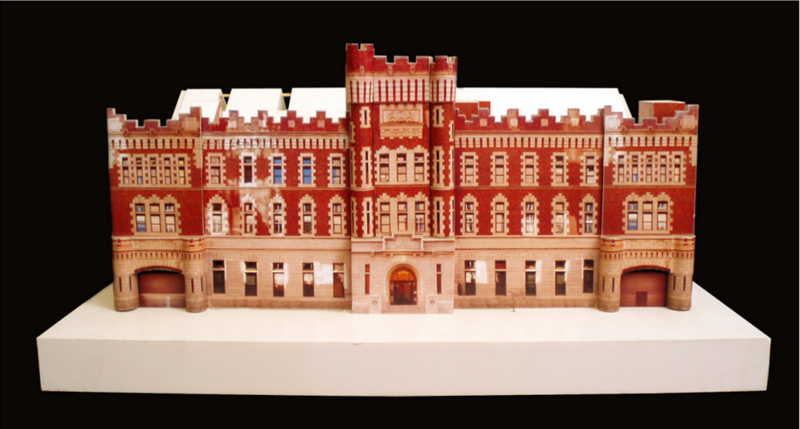
-
When Habonim conducted a strategic review in 2006, our physical infrastructure was a top concern identified by the congregation, and a task force was created to investigate. When Elaine Witkoff became President, she tapped Lew Krulwich to lead this specific effort, which began in 2012.
-
By then, our aging building required substantial and costly repairs, providing a financial reason to explore a new facility, and we also hoped to find a result that would put us on more solid footing for the long term.
In 2013, the Real Estate Committee presented the congregation with several options that had been researched:
1. Raise money (likely $20 million or more) to move to a temporary home and completely renovate and expand our old building. This was deemed financially unfeasible.
2. Sell our old property and move to a new home elsewhere in the neighborhood. An exhaustive search of all potential West Side locations between 57th and 86th Streets was conducted, and only 2 potential sites were identified to consider for this option.
3. Sell our property, move to a temporary home, and then move back to the base of a new building to be constructed on the site. Only two feasible sites, including our current location at 103 West End Avenue, were found as potential temporary homes.
4. Doing nothing was certainly considered but rejected as unfeasible for the long term survival of Habonim.
Why did we make the decision we did?
The option chosen gave us the best possible future home for Habonim for decades to come, and was superior to the other options based on all of our criteria, including:
1. Location: while moving to another permanent site on the Upper West Side was seriously considered, returning to our historic location was the strong preference.
2. Size: our current option gave us by far the most and best new space, allowing Habonim to expand its programming and activities far into the future.
3. Design: This option allowed Habonim to design and construct its own space, building a beautiful new home for our congregation reflecting our history, values and sensibility. In particular, this option uniquely allowed us to both have a temporary home for our Nursery School (not easy to find) and grow our school in the future with seven incredible classrooms and our own private outdoor play space.
4. Economics: the timing of selling our property when we did was advantageous, especially once Disney sold to the same developer their properties directly to the east of our old building, increasing the value of our property.
The Habonim Board unanimously approved this course of action, and the congregation voted overwhelmingly (over 90%) in favor of moving forward.
What was the nature of the deal?
In 2014, we signed a deal with a developer called Extell to sell our building and land on 66th Street. In exchange, we received a condominium unit, which we will own, in a new building to be built on the site, plus cash that a) enabled us to rent and build out a temporary home at 103 West End Avenue, b) will enable us to build out and finish the new synagogue from the empty raw shell we will receive in our condo unit in the new building on 65th Street, and c) will leave us with funds to put Habonim on more solid financial footing for the future, so we can operate in the new, larger synagogue for many years to come. Our new home will be close to triple the size of our old building (and of our current space) with significant outdoor space. In the contract, we negotiated a long list of minimum requirements for our space in the building (well before the building was designed, so this was not a trivial exercise). We also had various protections in this rather complicated transaction, including significant penalties for delays, and the fact that no one can build on this site without building us our synagogue.
What has taken so long?
Habonim is not involved with the construction of the overall building which will house our new home. Unfortunately, there have been several delays holding up the process of the building's construction.
First, Extell acquired the former Lighthouse/Jewish Guild for the Blind building on 65th Street, directly behind our old synagogue building on 66th Street. We knew at the time of our sale in 2014 that this was a possibility, but it unexpectedly delayed the project by close to 3 years, as Extell negotiated and closed that purchase, the Guild exited the building and moved their staff and students to other locations, and that large building was then demolished.
The expansion of the site to include the Guild property, while delaying our plans, resulted in a far better footprint for Habonim - more square footage (both indoors and outdoors), higher ceilings, the entire 65th Street frontage of the building belonging to Habonim (as opposed to sharing 66th St with the residential entrance), and the majority of our space on the ground floor rather than spread to a second floor.
From November 2017 until August of 2019, we saw work beginning at the construction site, including demolition, creation of the foundation, and construction up to the ground level (see photos here). Then a second delay, until the spring of 2022, occurred as various legal and regulatory challenges were filed against the building. Although all of these challenges eventually failed, the resolution of them, exacerbated by Covid's closing of courts, resulted in construction work shutting down for this time period. Construction of the building resumed in 2022.
Lastly, the construction logistics of the overall building have us waiting on the pieces of our space to be constructed and turned over to us. Although our space is on the ground floor and basement, there are currently various elements of the overall building's construction (e.g., cement trucks, loading docks, external elevators) that are in parts of our future space. As these elements are cleared out, we will get access to our space to begin our build-out work.
*********************************************************************************************************************************************************






